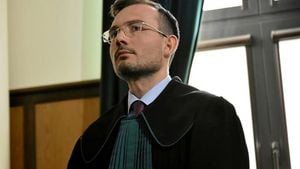DAZN recently made history by broadcasting its largest UEFA Champions League conference yet, covering all 18 matches played simultaneously on January 29, 2025. This unprecedented event marked the finale of the new league phase, with all games kicking off at the same time, generating excitement among football fans across the globe.
The scale of this broadcasting endeavor was impressive. Approximately 500 staff members were involved, including 18 commentators, all stationed at DAZN’s studio facilities. The production team, led by DAZN Chief Editor Jörg Zwacka, showcased the advanced infrastructure and teamwork required to manage such a complex event. "We aim to make history with this broadcast. It's something we've never done before, and we want viewers to enjoy themselves," Zwacka stated, explaining the network's ambition as they took on the greatest challenge yet.
Football fans had been eagerly anticipating the day, as the stakes were high for several clubs. Only FC Liverpool and FC Barcelona had secured their positions for the knockout stage, leaving 25 clubs vying for their chances to progress, either to the Round of 16 or to the playoff stage. Germany’s top teams, Bayer Leverkusen, Borussia Dortmund, and Bayern Munich, were among those aiming for the prestigious top eight spots, contributing to the charged atmosphere surrounding the event.
The matchday broadcast commenced with pre-show analysis at 19:30 UTC, leading up to one of the most awaited moments—the kickoff at 21:00 UTC. The atmosphere was electric as fans tuned in to experience what was billed as the largest football conference ever seen. The standout feature of the conference was not just the simultaneous nature of the matches but also the high-impact commentary delivered by the seasoned team of reporters. "Tor in Mailand! Tor in Salzburg! Tor in Stuttgart!" echoed through the studio as excitement grew with every goal scored across the matches.
Behind the scenes, the production team worked tirelessly to manage the chaos created by numerous commentators simultaneously reporting on multiple matches. David Ploch, who commented on the game between Lille and Feyenoord, shared the unique pressures of the conference: “It’s exciting but challenging, considering the number of matches and the potential for overlapping events. We're balancing priorities between matches with varying stakes.”
Compounding the excitement was the fact each match was integral to the clubs involved. The relationship between success and progress was apparent. The tension escalated as German teams competed fiercely for qualification. Borussia Dortmund played against Shakhtar Donetsk, Bayer Leverkusen met Prague, and Bayern Munich faced off against Bratislava—all games made thrilling by the stakes at hand.
Once kickoff commenced, coordinated visuals from the control room tracked each scoring opportunity, managing the flow of the conference with remarkable efficiency. The directing team kept sight of the hectic environment, ensuring every breakthrough and goal was captured for the audience. Commentators seamlessly switched between games, celebrating and analyzing as ripple effects from each match influenced the others.
Fans were not just spectators but participants, feeling the thrill of every goal scored across the league, with action and drama packed tightly during the three-hour broadcast. The rapid-fire updates of goals, with some matches seeing multiple scores within minutes of each other, kept viewers on their toes.
At the end of the night, DAZN’s 18-match conference produced 64 goals, each celebrated exuberantly as announcers juggled attention between games, building suspense for the audience. Laura Wontorra, moderatoress for the event, noted the palpable energy and excitement: "This was not just a broadcast but an event; everyone onboard put their best foot forward for this unique occasion. We can wholeheartedly say, it was top class."
This landmark moment marks not just the historic event for DAZN but sets the bar high for future broadcasts. The enthusiasm and production quality will undoubtedly influence how sports coverage evolves, captivating loyal fans and potentially drawing new viewers as they witness such high-stakes football action live.



